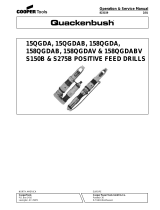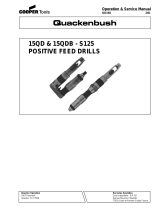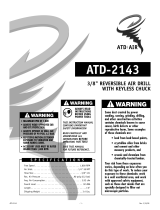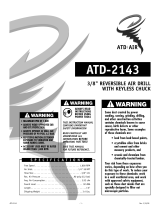
20
MAINTENANCE SECTION
3. If the tool is equipped with a Memory Chip (9),
install it (with the leads entering first) in the pocket at
the bottom of the Back Cap.
4. Make certain the tab on the inside edge of the Back
Cap Gasket (7) is aligned with the pocket for the
Memory Chip and in stall the Gasket, me tal face lead-
ing, in the recess o f the Back Cap against the face
with the cavity containing the Muffler Elements.
5. Position the gasket end of th e alignment dowel
against the inlet hub on the Motor Housing. Align
the flats on the Cap with the flats on the Ho using.
Orient the Back Cap and slide the Back Cap Assem-
bly off the alignment dowel and onto the Motor
Housing.
6. The Exhaust Diffuser (15) has one slot that is longer
than the o ther five slots. The Back Cap has a short,
molded stud projecting from inlet end. Place the Ex-
haust Diffuser against the Back Cap with the long slot
encircling the molded stud. Rotate the Diffuser coun-
terclockwise until the wall of the slot stops against
the stud. The exhaust ports are now in the full open
position which will provide maximum free speed .
7. Being carefu l not to damage it, insert the Throttle
Valve Seat (12) into th e central op ening at th e inlet
end o f the Motor Housing at an angle until it clears
the threads in the Housing. Using a rod with a flat
end and no sharp edges, push the Seat to the bottom
of the opening until it seats flush.
8. Using needle nose pliers, insert the Throttle Valv e
(13), long stem leading, into the opening against the
Seat. Center the Valve in the Seat.
9. Install the Thro ttle Valve Sprin g (14) in the opening
so that it encircles the Valve.
10. If the Inlet Screen (18) required r eplacement, use a
wooden dowel to carefully push a new one into the
Inlet Bushing (16).
11. If the Inlet Bushing Seal (17) is nicked or damaged,
carefully install a new one over the threads of the
Inlet Bushing.
12. Thread the Inlet Bushing Assembly through the Dif-
fuser and Back Cap into the Motor Housing. Using a
1 --3/16” wrench on the flats of the Back Cap to keep
it from turning, tighten the Inlet Bushing between 15
and20ft--lbs.(20and27Nm)torque.
13. The Throttle Plunger ( 5) has a lengthwise flat on the
outer edge at one end of the Plunger. Insert the
Plunger, flat end first, into the cross hole in the Hous-
ing. Push on the end of the Plunger to make certain it
springs back from contact with the stem of the
Throttle Valve.
14. Position the Throttle Lever (10) in the slot in the
Back Cap and Motor Housing and using a 1/16” di-
ameter rod, align the holes through the Back Cap,
Motor Hou sin g and Throttle Lever. While maintain-
ing alignm ent, install th e Throttle Lever Pin (11) in
place of the rod by tapping it through all three pieces.
15. Remove the assembled Housing from the vise jaws.
16. Lightly grasp the flats at the inlet end of the Motor
Housing in leather--covered o r copper--covered vise
jaws with the motor bore upward.
17. Grasp the spline of the Rotor (26) in the assembled
motor and after aligning the End Plate Alignment Pin
(29) with the internal notch in the motor end of the
housing bore, insert the assembled motor into the
Motor Housing. Make certain the motor is far
enough into the Housing to have the undercut below
the internal housing thread visible.
18. Lubricate the Motor Seal (31) with o-- ring lubricant
and install it around the Front End Plate (28) and into
the undercut in the Housing.
19. Align the tab of the Motor Clamp Washer (32) with
the internal notch in the Housing and install it over
the rotor hub and End Plate Alignment Pin against the
Motor Seal. Make certain th e Pin enters the ho le in
the Washer and the Washer is flat against th e Seal.
20. Apply some Ingersoll--Rand No. 67 Grease to the
spline on the rotor shaft.
21. Thread the assembled Gear Case (41) and Spindle
Assembly (40), gear case end leading, into the Motor
Housing and tighten the joint between 15 and 2 0 ft--
lbs. (20 and 27 Nm) torque.
22. Install the Housing Grip (43), internal slotted end
leading, over the Gear Case and Housing and engage
the slots in the Grip with the projections on the Hous-
ing.
23. Install the Grip Retainer (42) in the groove on the
Gear Case to secure the Grip.
24. Remove the tool from the vise jaws and thread the
Chuck (50) onto the Spindle.
25. Check the free speed of the tool using a tachometer
and following the instructions in the SPEED AD-
JUSTMENT section of this manual.

























